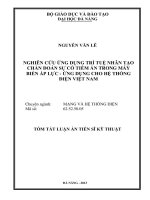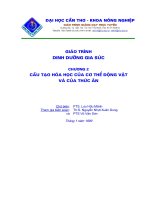Tài liệu đào tạo chẩn đoán động cơ engine (ODB2)
Bạn đang xem bản rút gọn của tài liệu. Xem và tải ngay bản đầy đủ của tài liệu tại đây (6.83 MB, 268 trang )
MODE SENSORS AND SWITCHES
Position/Mode Sensors and Switches
For many components, it is important that the ECM know the position and/or mode of the
component. A switch is used as a sensor to indicate a position or mode. The switch may be on
the supply side or the ground side of a circuit.
Power Side Switch Circuit
A power side switch is a switch located between the power supply and load. Sometimes the
power side switch is called hot side switch because it is located on the hot side, that is, before
the load, in a circuit. The Stop Lamp switch is a good example. When the brake pedal is
depressed, the Stop Lamp switch closes sending battery voltage to the ECM. This signals the
ECM that the vehicle is braking.
Page 1 © Toyota Motor Sales, U.S.A., Inc. All Rights Reserved.
MODE SENSORS AND SWITCHES
The following switches act as switches for the ECM. Usually, they are supply side switches.
Note in the figure(s) their location between the battery and ECM. Many switches that commonly
use battery voltage as the source are:
• Ignition Switch.
• Park/Neutral Switch.
• Transfer Low Position Detection Switch.
• Transfer Neutral Position Detection Switch.
• Transfer 4V;D Detection Switch.
Page 2 © Toyota Motor Sales, U.S.A., Inc. All Rights Reserved.
MODE SENSORS AND SWITCHES
Page 3 © Toyota Motor Sales, U.S.A., Inc. All Rights Reserved.
MODE SENSORS AND SWITCHES
Ground Side Switch Circuit
A ground side switch is located between the load and ground in a circuit. Inside the ECM there
is resistor (load) connected in series to the switch. The ECM measures the available voltage
between the resistor and switch. When the switch is open, the ECM reads supply voltage. When
the switch is closed, voltage is nearly zero.
The following switches are typically found on the ground side of the circuit:
• TPS Idle Contact (IDL signal) The TPS Idle Contact Switch uses a 12 volt reference
voltage from the ECM.
• Power Steering Pressure Switch.
• Overdrive Switch.
Page 4 © Toyota Motor Sales, U.S.A., Inc. All Rights Reserved.
MODE SENSORS AND SWITCHES
Page 5 © Toyota Motor Sales, U.S.A., Inc. All Rights Reserved.
MODE SENSORS AND SWITCHES
Page 6 © Toyota Motor Sales, U.S.A., Inc. All Rights Reserved.
TEMPERATURE SENSORS
Temperature Sensors
The ECM needs to adjust a variety of systems based on temperatures. It is critical for proper
operation of these systems that the engine reach operating temperature and the temperature is
accurately signaled to the ECM. For example, for the proper amount of fuel to be injected the
ECM must know the correct engine temperature. Temperature sensors measure Engine
Coolant Temperature (ECT), Intake Air Temperature (IAT) and Exhaust Recirculation Gases
(EGR), etc.
Page 1 © Toyota Motor Sales, U.S.A., Inc. All Rights Reserved.
TEMPERATURE SENSORS
Engine Coolant Temperature (ECT) Sensor
The ECT responds to change in Engine Coolant Temperature. By measuring engine coolant
temperature, the ECM knows the average temperature of the engine. The ECT is usually
located in a coolant passage just before the thermostat. The ECT is connected to the THW
terminal on the ECM.
The ECT sensor is critical to many ECM functions such as fuel injection, ignition timing, variable
valve timing, transmission shifting, etc. Always check to see if the engine is at operating
temperature and that the ECT is accurately reporting the temperature to the ECM.
Intake Air Temperature (IAT) Sensor
The IAT detects the temperature of the incoming air stream. On vehicles equipped with a MAP
sensor, the IAT is located in an intake air passage. On Mass Air Flow sensor equipped
vehicles, the IAT is part of the MAF sensor. The IAT is connected to the THA terminal on the
ECM. The IAT is used for detecting ambient temperature on a cold start and intake air
temperature as the engine heats up the incoming air.
NOTE: One strategy the ECM uses to determine a cold engine start is by comparing the ECT
and IAT signals. If both are within 8'C (15'F) of each other, the ECM assumes it is a cold start.
This strategy is important because some diagnostic monitors, such as the EVAP monitor, are
based on a cold start.
Page 2 © Toyota Motor Sales, U.S.A., Inc. All Rights Reserved.
TEMPERATURE SENSORS
Exhaust Gas Recirculation (EGR) Temperature Sensor
The EGR Temperature Sensor is located in the EGR passage and measures the temperature
of the exhaust gases. The EGR Temp sensor is connected to the THG terminal on the ECM.
When the EGR valve opens, temperature increases. From the increase in temperature, the
ECM knows the EGR valve is open and that exhaust gases are flowing.
Page 3 © Toyota Motor Sales, U.S.A., Inc. All Rights Reserved.
TEMPERATURE SENSORS
ECT, IAT, & EGR Temperature Sensor Operation
Though these sensors are measuring different things, they all operate in the same way. From
the voltage signal of the temperature sensor, the ECM knows the temperature. As the
temperature of the sensor heats up, the voltage signal decreases. The decrease in the voltage
signal is caused by the decrease in resistance. The change in resistance causes the voltage
signal to drop.
The temperature sensor is connected in series to a fixed value resistor. The ECM supplies 5
volts to the circuit and measures the change in voltage between the fixed value resistor and the
temperature sensor.
When the sensor is cold, the resistance of the sensor is high, and the voltage signal is high. As
the sensor warms up, the resistance drops and voltage signal decreases. From the voltage
signal, the ECM can determine the temperature of the coolant, intake air, or exhaust gas
temperature.
The ground wire of the temperature sensors is always at the ECU usually terminal E2. These
sensors are classified as thermistors.
Temperature Sensor Diagnostics
Temperature sensor circuits are tested for:
• opens.
• shorts.
• available voltage.
• sensor resistance.
The Diagnostic Tester data list can reveal the type of problem. An open circuit (high resistance)
will read the coldest temperature possible. A shorted circuit (low resistance) will read the
highest temperature possible. The diagnostic procedure purpose is to isolate and identify the
temperature sensor from the circuit and ECM.
High resistance in the temperature circuit will cause the ECM to think that the temperature is
colder than it really is. For example, as the engine warms up, ECT resistance decreases, but
unwanted extra resistance in the circuit will produce a higher voltage drop signal. This will most
likely be noticed when the engine has reached operating temperatures. Note that at the upper
end of the temperature/resistance scale, ECT resistance changes very little. Extra resistance in
the higher temperature can cause the ECM to think the engine is approximately 20'F = 30'F
colder than actual temperature. This will cause poor engine performance, fuel economy, and
possibly engine overheating.
Page 4 © Toyota Motor Sales, U.S.A., Inc. All Rights Reserved.
TEMPERATURE SENSORS
Solving Open Circuit Problems
A jumper wire and Diagnostic Tester are used to locate the problem in an open circuit.
Page 5 © Toyota Motor Sales, U.S.A., Inc. All Rights Reserved.
TEMPERATURE SENSORS
Solving Shorted Circuit Problems
Creating an open circuit at different points in the temperature circuit will isolate the short. The
temperature reading should go extremely low (cold) when an open is created.
Page 6 © Toyota Motor Sales, U.S.A., Inc. All Rights Reserved.
TEMPERATURE SENSORS
ASSIGNMENT
NAME: ___________________________
1. List the three types of temperature sensors used and explain the function of each?
2. Temperature sensors are actually ______________?
3. Draw a sample temperature sensor circuit. (Label all parts)
4. The ECT us used by the computer to control what functions?
5. What PCM strategy is used when both the IAT and ECT are within 15’F of each other?
6. Temperature sensors are tested for:
7. Describe the procedure of testing a temperature sensor.
Page 7 © Toyota Motor Sales, U.S.A., Inc. All Rights Reserved.
POSITION SENSORS
Position Sensors
In many applications, the ECM needs to know the position of mechanical components. The
Throttle Position Sensor (TPS) indicates position of the throttle valve. Accelerator Pedal Position
(APP) sensor indicates position of the accelerator pedal. Exhaust Gas Valve (EGR) Valve
Position Sensor indicates position of the EGR Valve. The vane air flow meter uses this
principle.
Electrically, these sensors operate the same way. A wiper arm inside the sensor is
mechanically connected to a moving part, such as a valve or vane. As the part moves, the wiper
arm also moves. The wiper arm is also in contact with a resistor. As the wiper arm moves on
the resistor, the signal voltage output changes. At the point of contact the available voltage is the
signal voltage and this indicates position. The closer the wiper arm gets to VC voltage, the
higher the signal voltage output. From this voltage, the ECM is able to determine the position of
a component.
Page 1 © Toyota Motor Sales, U.S.A., Inc. All Rights Reserved.
POSITION SENSORS
Throttle Position Sensor
The TPS is mounted on the throttle body and converts the throttle valve angle into an electrical
signal. As the throttle opens, the signal voltage increases.
The ECM uses throttle valve position information to know:
• engine mode: idle, part throttle, wide open throttle.
• switch off AC and emission controls at Wide Open Throttle (WOT).
• air-fuel ratio correction.
• power increase correction.
• fuel cut control.
The basic TPS requires three wires. Five volts are supplied to the TPS from the VC terminal of
the ECM. The TPS voltage signal is supplied to the VTA terminal. A ground wire from the TPS to
the E2 terminal of the ECM completes the circuit.
At idle, voltage is approximately 0.6 - 0.9 volts on the signal wire. From this voltage, the ECM
knows the throttle plate is closed. At wide open throttle, signal voltage is approximately 3.5 - 4.7
volts.
Inside the TPS is a resistor and a wiper arm. The arm is always contacting the resistor. At the
point of contact, the available voltage is the signal voltage and this indicates throttle valve
position. At idle, the resistance between the VC (or VCC terminal and VTA terminal is high,
therefore, the available voltage is approximately 0.6 - 0.9 volts. As the contact arm moves closer
the VC terminal (the 5 volt power voltage), resistance decreases and the voltage signal
increases.
Page 2 © Toyota Motor Sales, U.S.A., Inc. All Rights Reserved.
POSITION SENSORS
Some TPS incorporate a Closed Throttle Position switch (also called an idle contact switch).
This switch is closed when the throttle valve is closed. At this point, the ECM measures 0 volts
and there is 0 volts at the IDL terminal. When the throttle is opened, the switch opens and the
ECM reads +B voltage at the IDL circuit.
Page 3 © Toyota Motor Sales, U.S.A., Inc. All Rights Reserved.
POSITION SENSORS
The TPS on the ETCS-i system has two contact arms and to resistors in one housing. The first
signal line is VTA1 and the second signal line is VTA2.
VTA2 works the same, but starts at a higher voltage output and the voltage change rate is
different from VTA1 As the throttle opens the two voltage signals increase at a different rate. The
ECM uses both signals to detect the change in throttle valve position. By having two sensors,
ECM can compare the voltages and detect problems.
Page 4 © Toyota Motor Sales, U.S.A., Inc. All Rights Reserved.
POSITION SENSORS
Accelerator Pedal Position (APP) Sensor
The APP sensor is mounted on the throttle body of the ETCS-i. The APP sensor converts the
accelerator pedal movement and position into two electrical signals. Electrically, the APP is
identical in operation to the TPS.
EGR Valve Position Sensor
The EGR Valve Position Sensor is mounted on the EGR valve and detects the height of the EGR
valve. The ECM uses this signal to control EGR valve height. The EGR Valve Position Sensor
converts the movement and position of the EGR valve into an electrical signal. Operation is
identical to the TPS except that the signal arm is moved by the EGR valve.
Position Sensor Diagnostics
The following explanations are to help you with the diagnostic procedures in the Repair Manual.
The explanations below are representative to the order listed in the RM. You may find different
orders in the RM.
Diagnostic Tester
Comparing the position of the sensor to Diagnostic Tester data is a convenient way of
observing sensor operation. For example, with the TPS, the lowest percentage measured with
Key On/Engine Off is with the throttle valve at its minimum setting, and the highest percentage
will be at Wide Open Throttle.
Page 5 © Toyota Motor Sales, U.S.A., Inc. All Rights Reserved.
POSITION SENSORS
Inspect Throttle Position Sensor
On some models, you will find TPS checks in the Throttle Body on Vehicle Inspection in the SF
Section.
Page 6 © Toyota Motor Sales, U.S.A., Inc. All Rights Reserved.
POSITION SENSORS
Page 7 © Toyota Motor Sales, U.S.A., Inc. All Rights Reserved.
POSITION SENSORS
ASSIGNMENT
NAME: ___________________________
1. What are some of the common uses of position sensors? List them.
2. Explain how a position sensor (potentiometer) works?
3. Draw a sample position sensor circuit. Label all parts.
4. The PCM (ECM) uses throttle valve position information to control what functions?
5. Why do some TPS have an IDL contact and how does the PCM use this information?
6. What are the typical voltage values of a TPS? (Reference, idle, WOT)
7. Why does the PCM use an EGR position sensor and how is it used? Explain the strategy
behind this sensor.
8. Explain the testing procedure for a position sensor such as a TPS. (In detail)
Page 8 © Toyota Motor Sales, U.S.A., Inc. All Rights Reserved.
AIR FLOW SENSORS
Mass Air Flow (MAF) Sensors
The Mass Air Flow Sensors converts the amount of air drawn into the engine into a voltage
signal. The ECM needs to know intake air volume to calculate engine load. This is necessary to
determine how much fuel to inject, when to ignite the cylinder, and when to shift the
transmission. The air flow sensor is located directly in the intake air stream, between the air
cleaner and throttle body where it can measure incoming air.
There are different types of Mass Air Flow sensors. The vane air flow meter and Karmen vortex
are two older styles of air flow sensors and they can be identified by their shape. The newer,
and more common is the Mass Air Flow (MAF) sensor.
Mass Air Flow Sensor: Hot Wire Type
The primary components of the MAF sensor are a thermistor, a platinum hot wire, and an
electronic control circuit.
The thermistor measures the temperature of the incoming air. The hot wire is maintained at a
constant temperature in relation to the thermistor by the electronic control circuit. An increase in
Page 1 © Toyota Motor Sales, U.S.A., Inc. All Rights Reserved.
AIR FLOW SENSORS
air flow will cause the hot wire to lose heat faster and the electronic control circuitry will
compensate by sending more current through the wire. The electronic control circuit
simultaneously measures the current flow and puts out a voltage signal (VG) in proportion to
current flow.
This type of MAF sensor also has an Intake Air Temperature (IAT) sensor as part of the housing
assembly. Its operation is described in the IAT section of Temperature Sensors. When looking
at the EWD, there is a ground for the MAF sensor and a ground (E2) for the IAT sensor.
Page 2 © Toyota Motor Sales, U.S.A., Inc. All Rights Reserved.
AIR FLOW SENSORS
Diagnosis
Diagnosis of the MAF sensor involves visual, circuit, and component checks. The MAF sensor
passage must be free of debris to operate properly. If the passage is plugged, the engine will
usually start, but run poorly or stall and may not set a DTC.
Page 3 © Toyota Motor Sales, U.S.A., Inc. All Rights Reserved.
AIR FLOW SENSORS
Vane Air Flow Meter
The Vane Air Flow Meter provides the ECM with an accurate measure of the load placed on the
engine. The ECM uses it to calculate basic injection duration and basic ignition advance angle.
Vane Air Flow Meters consist of the following components:
• Measuring Plate.
• Compensation Plate.
• Return Spring.
• Potentiometer.
• Bypass Air Passage.
• Idle Adjusting Screw (factory adjusted).
• Fuel Pump Switch.
• Intake Air Temperature (IAT) Sensor.
Page 4 © Toyota Motor Sales, U.S.A., Inc. All Rights Reserved.









